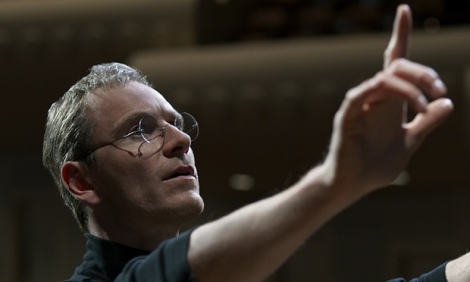
Danny Boyle’s latest film is a thrilling story about Steve Jobs, the creator of Apple Inc, told in different acts revolving around three, now historical, launches.
First launch came in 1984 with the launch of Macintosh computer, the friendly-face challenge not only to the supremacy of the PC but also to the future painted in Orwell’s 1984, as told in the legendary Apple add directed by Ridley Scott, which is precisely why Jobs was so adamant about it being able to say “hello”. Hollywood has made computers evil and sinister and it was Jobs’ job to shine a new light onto this problematic turning this malaise into praise and admiration.
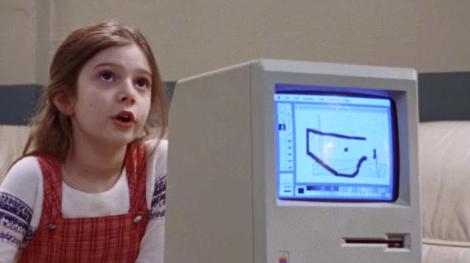
Meanwhile, in the backstage, behind the scenes, Jobs (Michael Fassbender) is forced to face his ex (Katherine Waterston) and the mother of his supposed daughter (Makenzie Moss, Ripley Sobo, Perla Haney-Jardine), who came not only to plea for more money, now that Jobs is the millionaire, but also to assail him for creating an algorithm that shows the probability for 28% of the male Americans to be the possible fathers of his daughter Lisa. Serving as the voice of reason, his right hand woman, Joanna Hoffman (Kate Winslett), marketing executive for Apple and NeXT, is also there. Determined to spare Lisa all this family drama she breaks the promise given to Steve, who is now left alone with furious Chrisann. The fight ended with Steve’s decision to give the girls more money and a brand new house to live in.

In 1988, an exile, fired from Apple by his father figure and a CEO (1983-1993) John Sculley (Jeff Daniels), and betrayed by his best friend, Steve Wozniak (Seth Rogen), Jobs prepares a launch of his NeXT system, a black box that does nothing. By 1998, with Sculley gone, and Apple buying his NeXT system, the prodigal son returns to his own company, in order to fulfill his cultural destiny by giving us the iMac. Minutes before the launch we see him running after his daughter Lisa, now nineteen-year-old girl preparing for Harvard, who is refusing to stay for the iMac launch having learned about the algorithm. Towards the end of their conversation, he points to her bulky Walkman annoyed with its size and the way she carries it around saying: “We are going to put 500 tunes, no 1000 tunes… Well something between 500 and 1000 tunes in your pocket”. Three years later the very first iPod was introduced to the world. On October 23rd Jobs announced it as a Mac-compatible product with a 5 GB hard drive that put “1,000 songs in your pocket.” And the rest is history.
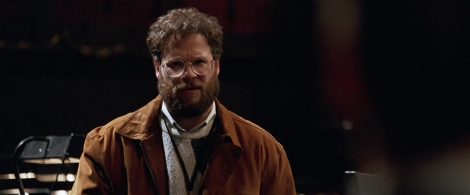
The genius of screenwriter Aaron Sorkin shines throughout this unorthodox biopic making it a worthy successor or a parable to Fincher’s masterful The Social Network, a story of another kid wiz, Mark Zuckerberg. In the former, the plot revolves around the milestones of Apple Inc. Company, which was a very bold yet necessary move, perhaps even crucial for the potability of the story. In the latter, as we already know, the story revolves around two separate lawsuits. Although distinctively different in topic (despite the fact they both talk about computer technology), the atmosphere and the rhythm is what brings these two films together. Sorkin’s script makes for a different Boyle, not necessarily better or worse, just more mature, more focused and theatrical Boyle, which is something we haven’t had the pleasure of experiencing up until now. Completed with flawless acting done on the part of Fassbender, Rogen, Winslett and Daniels, and Birdman-like camera shots and endless walks through the behind-the-scene corridors, the whole film is ridiculously good and entertaining.
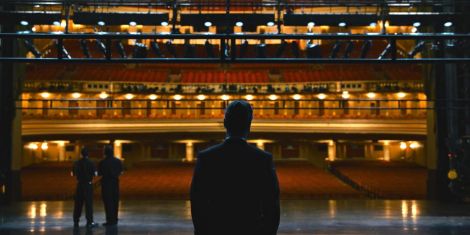
Boyle’s choice of giving the role of Steve Jobs to Michael Fassbender, who doesn’t look anything like the man he is suppose to portray, turned out to be the major asset and a great choice indeed. Fassbender’s ability to embody Jobs’ drive and the very essence of his being, the awkwardness, the cold façade and restlessness, annulled their apparent difference in appearance. And truly, from the very first line uttered all we could feel, see and hear on the big screen in front of us was Steve Jobs, the man who plays the orchestra, with no trace of Fassbender left for us to find. Coupled with Kate Winslet, this was a match made in enunciation heaven.
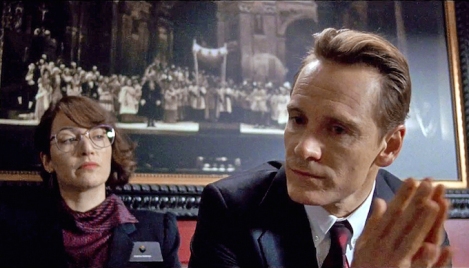
The energy of the film is endless, the pace and rhythm relentless. The whole film takes place almost entirely indoors, on stage, backstage and in the corridors connecting these two roles in life generally. On stage Steve Jobs is the God, the genius of the tech world, he is what he wants us to see. Backstage he is what he is, the relentless maniac, a workaholic sociopath despised by most people. Concurrently, these are also the only two spaces that provide for a little if any steadiness we might experience while watching this frantic parade of walking-and-talking down the hallways, up and down the stairs, doorways and so on, mixed with the crosscuts between past and present, often intersect with the abundance of dialogue. At times, the film felt like an exciting two hour long commercial for Apple. Not boring, not even for a second.
P.S. Have you noticed the subtle change in image quality that adjusted to the decade it was depicting? Yes, it was neat!
4.5/5
Written by Monika Ponjavic on her MacBook Pro
Reblogged this on Well Lackadaddy Aaron I drink your milkshake!.
LikeLike